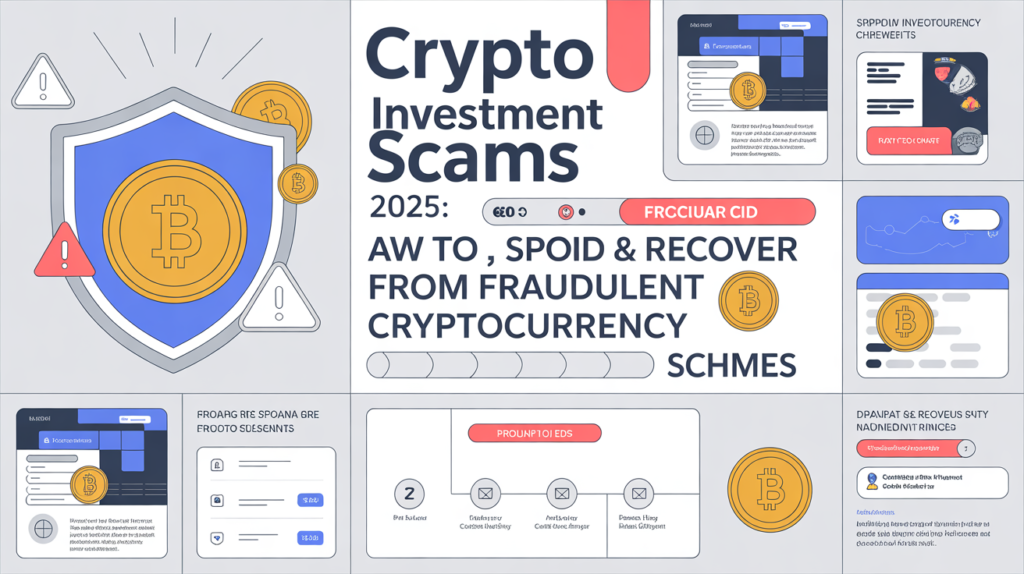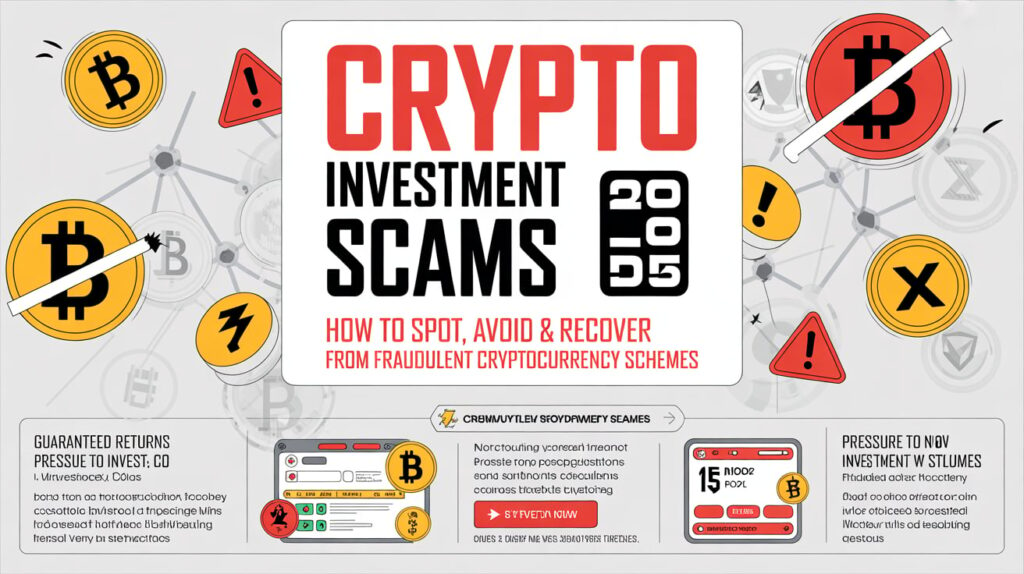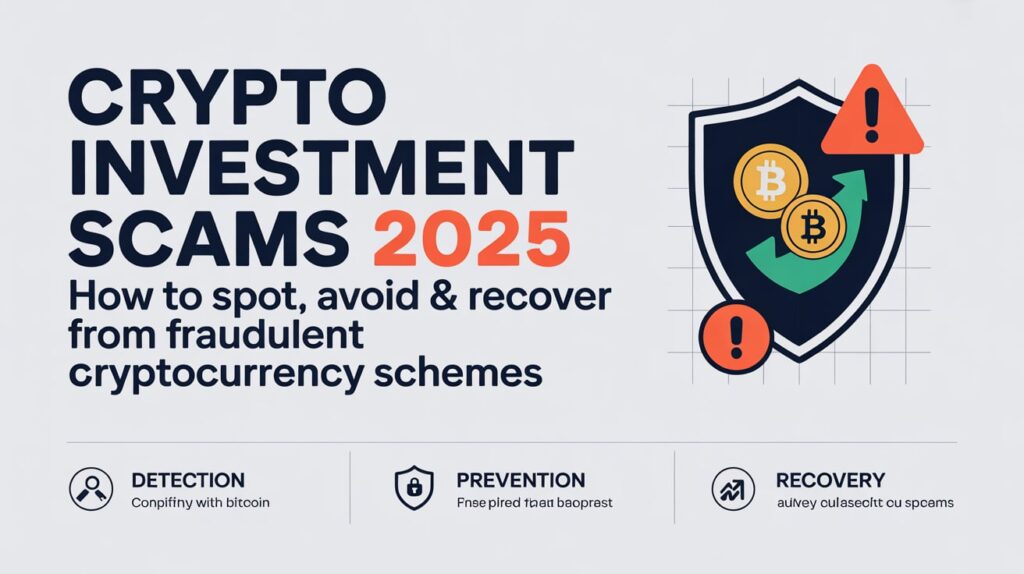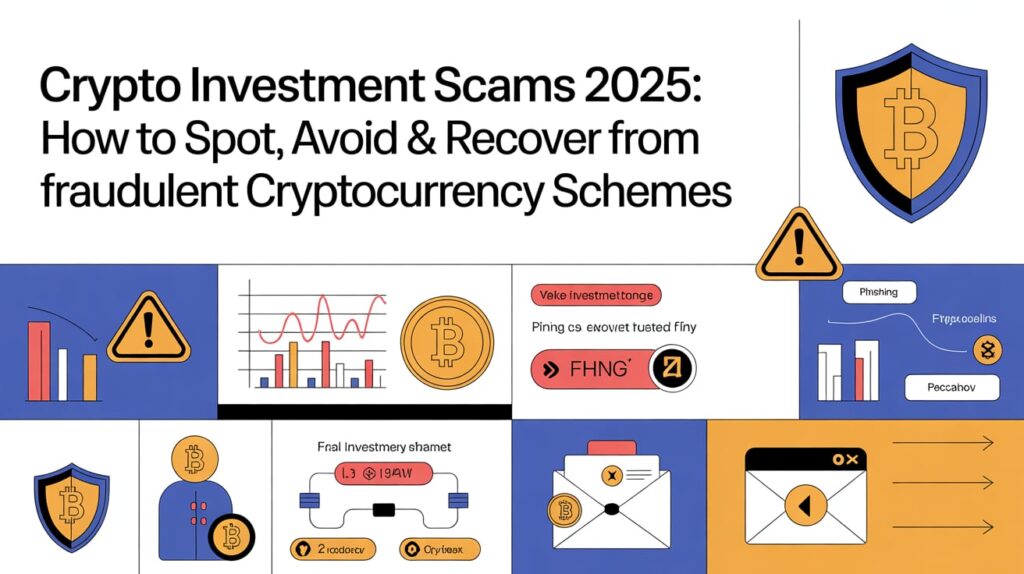Crypto Investment Scams 2025: How to Spot, Avoid & Recover from Fraudulent Cryptocurrency Schemes

he crypto-investment world has exploded in popularity, innovation and opportunity. But with that growth comes an equally formidable surge in fraudulent schemes. In 2025, unscrupulous actors are leveraging advanced technology, social engineering and global reach to perpetrate sophisticated crypto investment scams. This article dives deep into how these scams work, the red-flags to watch for, real-world case studies, and what you can do to protect yourself—whether you’re a seasoned crypto investor or a newcomer.
1. Why Crypto Investments Attract Scams
1.1 The promise of high returns
Cryptocurrencies promise rapid gains, cutting out intermediaries and offering alternative investment access. This makes them extremely attractive—but also very risky. Scammers exploit this by promoting “get-rich-quick” narratives.
1.2 Irreversibility & anonymity
As noted by the Federal Trade Commission, once crypto funds are sent, they are (in most cases) irretrievable. Consumer Advice+2Morgan Stanley+2 And the pseudonymous nature of many crypto networks gives scammers the cover they need.
1.3 Rapid innovation and regulatory gaps
New token launches, DeFi protocols, NFTs, and cross-border platforms all proliferate fast. However, regulatory frameworks often lag behind, creating fertile ground for fraud. Researchers have flagged fake ICOs, rug pulls and others as major concerns. Constantine Cannon+1
2. Common Types of Crypto Investment Scams
2.1 Fake ICOs & token launches
Fraudsters will launch tokens claiming revolutionary technology or guaranteed returns—but the project is hollow. Early investors may see some payments until the scheme collapses or the developers vanish. Constantine Cannon+1
2.2 Ponzi and pyramid schemes
Classic investment fraud has been adapted into crypto form: promoters promise high yields, recruit others, and pay early participants with funds from new ones. Eventually the scheme collapses and many lose money. Constantine Cannon
2.3 Pump-and-dump schemes
Especially common in small-cap cryptocurrencies: scammers hype a coin, inflate its price, then sell their holdings at the peak leaving others holding worthless tokens. Wikipedia+1
2.4 Fake exchanges/wallets & phishing
Scammers build websites, apps or wallets mimicking legitimate ones, then trick users into depositing funds or giving up private keys. rbcwealthmanagement.com+1
2.5 Romance / “pig-butchering” scams
In this type, scammers build personal relationships (online dating apps, social networks) and persuade the victim to invest in crypto schemes, often escalating investments over time. TechTarget+1
2.6 “Giveaway” or “investment opportunity” scams
These involve promises of free crypto, matched contributions, or guaranteed returns—if you deposit first. Then the funds vanish. DFPI+1
2.7 Job-offer scams
Scammers pose as employers offering crypto-related work-from-home gigs, often requiring you to advance funds or buy crypto as part of the job. Federal Bureau of Investigation

3. How Scams Work: The Anatomy of the Fraud
3.1 Luring the victim
Typically, an initial contact arrives via social media, email, dating sites or messaging apps. The scammer may pose as an influencer, investment manager or romantic partner.
3.2 Building trust
Through conversation over days or weeks, the fraudster builds a relationship, often sharing fake success stories, showing screenshots of “profits,” and convincing the victim they’re safe and credible.
3.3 The investment pitch
The victim is introduced to an “exclusive” crypto project, told they’ll make high returns, and often pressured to act quickly. Payment is required in crypto (which is harder to trace and reverse).
3.4 Entrapment and escalation
Once the victim invests, more and more funds may be requested, sometimes under the guise of “unlocking higher yields,” “buy-in minimums,” or “special access.” In pig-butchering scams, the investment may go on for months before collapse. Wikipedia
3.5 The exit / collapse
When the scammer has collected enough, they disappear, shut down websites or block access. The victim’s funds vanish, and often legal or recovery routes are limited because crypto is borderless and anonymous.
4. Key Red Flags & Warning Signs
Here are crucial indicators you should watch out for:
-
Promises of guaranteed high returns with little or no risk. If it sounds too good to be true—be highly skeptical. rbcwealthmanagement.com+1
-
Pressure to act quickly, or warnings you’ll miss out.
-
Requirement to pay or transfer crypto before getting access.
-
Unclear or non-existent regulation, lack of registration/licensing.
-
Requesting private keys, wallet backups or unusual authorization.
-
Use of celebrity endorsements or “as seen on” claims, but no verifiable proof. TechTarget
-
Website/app with poor contact info, unclear domain ownership, or lacks age/history. Commodity Futures Trading Commission+1
-
Investor testimonials that seem too polished or fabricated.
-
Promoters who recruit you to bring in others (classic pyramid traits).
-
Assets or investments that you cannot withdraw or transfer easily.
-
Relationships that morph into investment pressure (as with pig-butchering).
5. Real-World Case Studies
-
A scam activity tracker by the California Department of Financial Protection and Innovation (DFPI) lists multiple types of crypto scams including yield-farming fraud, investment group scams and pig-butchering. DFPI
-
A report notes that “fake celebrity endorsements”, fake websites and business-opportunity scams remain among the top categories of crypto fraud. rbcwealthmanagement.com
-
Researchers highlight that the NFT promotion ecosystem showed over 36% of projects promoted were fraudulent, often using bots and social-media manipulation. arXiv
6. Prevention: How to Protect Yourself
6.1 Due diligence
-
Research the project thoroughly: team, roadmap, whitepaper, history.
-
Verify regulatory registrations where applicable.
-
Check domain age, contact info, company disclosures.
-
Look for independent reviews and community feedback.
-
Be skeptical of high returns, especially if you’re asked to invest quickly.
6.2 Secure key practices

-
Never give out your private keys or seed phrases.
-
Use reputable wallets and exchanges.
-
Enable two-factor authentication (2FA).
-
Withdraw or transfer to cold storage where appropriate.
6.3 Use trusted platforms
Stick to well-known exchanges and platforms with transparent operations, clear terms, and visible regulation. Avoid unknown apps or websites that appear overnight.
6.4 Avoid emotional or relationship-based pressure
Scams like pig-butchering thrive on relationships (romantic or friendly) turning into investment pressure. Be mindful of anyone who suddenly pushes crypto investment whilst building a personal connection.
6.5 Keep funds diversified and within budget
Never invest more than you can afford to lose. Crypto remains high-risk. Think of it as a part of your portfolio, not the entire basis.
6.6 Report suspicious activity
If you suspect a scam: report it to your local cybercrime unit, financial regulator, or fraud tracking organisations. Early reporting helps protect others.
7. What to Do If You’ve Been Scammed
-
Document everything: screenshots, chat logs, transaction IDs.
-
Contact your exchange or wallet provider if applicable—though recovery is rare in crypto.
-
Report to authorities: financial regulators, cybercrime units, fraud hotlines.
-
Warn your social circle: especially if the scam uses networks or group chats you’re in.
-
Be cautious of “recovery scams”: scammers often prey on victims again by promising to recover lost funds—for a fee.
-
Learn from it: take the experience as a major lesson, and apply stricter security and verification going forward.
8. The Evolving Landscape: Scams in 2025 and Beyond
8.1 Use of AI & deepfakes
Scams are becoming more sophisticated: criminals now use AI-generated voices, deepfake videos of celebrities and influencers, fake voices of loved ones to demand crypto payments. This trend is rising sharply. New York Post
8.2 Decentralised finance (DeFi) risks
With DeFi protocols, yield farms, “liquidity mining” comes greater promise but also higher risk of “liquidity rug-pulls”, where the creators ditch the project and the funds vanish. Researchers warn about these new forms. arXiv+1
8.3 Global, cross-border fraud
Crypto scams increasingly operate with international networks, exploiting jurisdictional gaps and weaker regulation. Many victims find recovery difficult because of the global nature of funds.
8.4 Regulatory tightening
By 2025, many governments are strengthening regulation, requiring licences, disclosures and stronger oversight of digital-asset businesses. While this helps, it also signals that fraudsters will adapt quickly.
8.5 Education & consumer awareness
One key defence is education: informed investors are less likely to fall prey. Scams often succeed because of overwhelming pressure, emotional manipulation or lack of understanding.

9. Strategic Advice for Crypto Investors
9.1 Treat crypto investment like any high-risk asset
While it can offer growth opportunities, the risk of fraud and loss is higher than many mainstream investments. Apply portfolio theory accordingly.
9.2 Focus on credible projects
Look for tokens and platforms with strong track records, transparency, open-source code, reputable teams and real-world use cases.
9.3 Maintain liquidity and exit strategies
Scams often trap investors who cannot withdraw their assets. Understand how you’ll exit, what fees apply, and ensure you have control over your assets (keys/wallet).
9.4 Stay updated on fraud trends
New types of scams emerge continuously — pig-butchering, bot-based arbitrage scams, AI impersonation. Being aware gives you an edge.
9.5 Never rely purely on social-media influence
Just because a celebrity or influencer is promoting something does not make it legitimate. Many paid endorsements are not properly disclosed or may be fake. rbcwealthmanagement.com
10. Conclusion
Investing in cryptocurrencies offers tremendous potential—but it also comes with one of the highest levels of scam risk in modern finance. By 2025, we’re seeing scams evolve, become more technologically sophisticated and more emotionally manipulative. The difference between gaining and losing often comes down to your awareness, diligence and caution.
If you treat crypto investments with the same seriousness and skepticism you’d apply to any high-risk venture, you’ll be far better positioned. Understand the red flags, secure your assets, verify all claims, and always remember: if someone asks you to move your crypto now, it’s worth pausing to ask why.